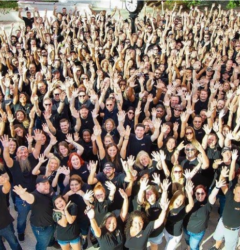Inside the Working of a Digital Studio — Interview with Joshua Davidson, Chop Dawg
05 Dec

Table of Contents
ToggleHelping turn ideas into products
Good products and collaboration go hand in hand. The former is simply not feasible without the latter. Collaboration has always been an area of prime interest for us, at zipBoard. Whether that is a collaboration between designers and developers, or agencies and clients.
Digital studios are a prime environment for both those cases. In our continuing endeavor to better understand how studios help create digital products, we spoke to Chop Dawg, a digital studio in Philadelphia.

Joshua Davidson started Chop Dawg at the young age of 16, with a simple vision — help people turn their ideas into real products. Today, Chop Dawg is close to 10 years into its existence and still going strong with the same motto. We talked to Joshua about the workings inside Chop Dawg, how they got here, why they are not calling themselves an app builder agency, and how they work with clients.
Starting Young
Even before Chop Dawg came around, Joshua was into building projects. It started with graphic design for the school message board and curiosity led Joshua to web design and CSS/HTML in the times of MySpace and building custom sites with Yahoo GeoCities. While he can’t say if there was one moment when he got hooked onto building products, building a website and getting ad revenue was something of note.

“When I was 13 or 14 years old, I built fan site for a local theme park near me. That ended up having thousands of users and making thousands of dollars in ad money. I eventually sold that and my interest in building things for the web was a natural progression.”
The curiosity in products and a drive for building things that people use led to Chop Dawg in 2009.
Transition From Website Design to Full Stack Development
“In the beginning it was pretty much a glorified website design company. We went door to door, asking small businesses in south [New] Jersey, trying to get them to let us build their website.”
In Joshua’s own words it was a “hard sell back then” because of the lack of emphasis on a digital presence. That, of course, has changed entirely and the first step in building a business is reserving your domain name.

By almost the second year of their operations, clients were reaching out to Chop Dawg to build more than just websites. As they interacted with clients with more elaborate business models and product requirements, Chop Dawg’s experience grew into building full-stack applications and software.
Today, Chop Dawg works with clients of all scales and sizes ranging from small startups to Fortune 500 companies. The range of projects is equally diverse. From websites, mobile apps, and software, to redesigning the entire back-end infrastructure, helping create operating systems for wearables and smart consumer electronics.
A Technical Partner
One of the points that Joshua emphasized is the scalability that hiring the correct design and development agency can bring to a team. This is one reason Chop Dawg does not call itself an “app development firm”.
“Let’s say you wanted to build an in-house tech team. You would need 2 developers, at least. A designer, minimum. A project manager, a CTO if you’re not technical, the infrastructure, servers etc. You need all of these things to run a technology arm to your company, if not an entire technology company. And that is considerable investment for any company.”
Chop Dawg does no think of itself as merely a studio for building one aspect of the tech side or a product. They aim to fill the technical gap that creates an entry barrier for budding entrepreneurs and start-ups to scale up their operations.

Because of this, Chop Dawg is not married to one particular technology or tech stack for development. The focus is on helping the client realize their product vision irrespective of it being on iOS, Android, Web, or a wearable.
Instead of investing in an in-house team with a considerable overhead on training and maintaining the team, Chop Dawg’s team of designers, developers, and project managers, become an extension of the client’s team.
Working with clients
This is how Chop Dawg set out to work from the beginning, and the process of acting as an auxiliary arm for their clients has been refined over the past 9 years.

For any such arrangement to work, trust is a key component. It starts with a transparent fixed-price contract with the clients. No charges by the hour, day, week, or month.
The scope of the project is defined early on and ironed out in as much detail as possible.
“We collaborate with clients heavily during the discovery phase of the project. Our job is to get them to break down everything that they would like to build. Tell us everything they visualize for the product. We help them connect the dots and articulate specifics. In essence, we help them define everything before we get started so that they are put in a position to succeed.
Of course, there is room to manoeuvre, but putting constraints and functionality into details helps curtail the project from becoming a runaway train with endless scope creep.
So say, we’re making a messaging app like iMessage or Facebook Messenger. These apps will show how many unread messages there are. Now, one interpretation of this is by the number of unread threads. Another interpretation could be by the number of unread messages for each unread thread. We make sure not to leave such things open to miscommunication and confusion by defining all these details. That way there’s no frustration later for our clients or our programming team.”



Another component of building a trustworthy relationship with the client is having close communication. Chop Dawg reviews the status of the project every week with their clients over Google Hangouts or Google Meet. The clients also get everyone’s personal email and text message contact. They can email or connect with anyone on the project when need be.
The Process: From Discovery to Launch
The discovery phase is crucial to kick-off the project, with features, functionality, and constraints specified in as much detail as possible.
All the details are then sketched up into low-fidelity mocks and wireframes. Once the look and feel of the product have been finalized from wireframes, product flows are sketched out.

With product flows, the team maps out every possible outcome for the user when using the product. The touch of a button, a swipe, a two-finger gesture — any interaction that could possibly be generated by interacting with the product is visualized and articulated. They also help the designer and developers collaborate better because there is sufficient context for both to communicate effectively, on the designs.
“A product flow consists of every screen, in order, start to finish. Each screen in turn has annotation notes on every feature and functionality. What triggers an email, what causes push notifications, where data goes, how it should behave etc. for every single piece.
This has helped save us so much time in testing and QA, esp. if the design is correct but execution is misinterpreted.”
Once the team and clients have agreed upon the product workflows, the product goes into the development stage. The project manager coordinates with the development team to make sure things progress as per the project plan agreed upon and makes sure that continuous QA testing is done in tandem. Bugs found in the testing phase are assigned priority(P1, P2, or P3), and squashed accordingly.
The Tools that Help
- For virtual meetings: Google Hangouts, Google Meet
- For communication and collaboration: Slack, G Suite, Trello
- For project management: Team Gantt
- For prototyping: InVision
The close collaboration on the project is not just a short-term engagement. As Joshua tells us, 80% of their customers stay with them beyond the first year of the contract.
Chop Dawg also helps spread the word about the product via its extensive social media presence. We asked Joshua how they have cultivated this social media presence:
“You have to add real value on social media. Most people put noise out on social media and if you do the same, you’re just not going to stand out. You have put out real things that people really care about. Just non-BS stuff that relates to your target audience.”
While he wishes he could spend more time interacting with his target audience on social media, Joshua sure keeps himself busy with his speaking engagements, podcasts, videos (like the one above), his work as a startup advisor, and as a volunteer at various charities.
He learns by reading more and interacting with other experienced entrepreneurs. And while he doesn’t code or create websites himself anymore, he prefers now to “work on his company, rather than in it.” True to someone who started so young, Joshua advises other budding entrepreneurs to just start working on whatever ideas they have and get out there.
Joshua continues to envision Chop Dawg as a partner for other companies and individuals to turn their ideas into great products.
“The future is getting more technical but for every technical company likes us out there, there are 10 non-technical companies coming up. We’re simply helping lower the cost of entry for them.”
We wish Joshua Davidson and his team at Chop Dawg the very best in their effort to do so.
Request Demo
Request a personalized demo of zipBoard to work collaboratively with your stakeholders on all your development projects in one place
Get DemoRecent Posts
- Why Your Team Needs a Content Feedback System (Not Just Comments in Docs) May 28, 2025
- Content Approvals Are Slowing You Down — Here’s the Fix May 26, 2025
- How to Streamline Content Review and Approval — Best Practices, Tools & Automation May 12, 2025
- What Is Content Operations? And Why It Breaks Without a Feedback & Approval System May 3, 2025
- Why Designers Need a Website Visual Feedback Tool: Improve Design Reviews & Client Collaboration April 25, 2025
©️ Copyright 2023 zipBoard Tech. All rights reserved.


